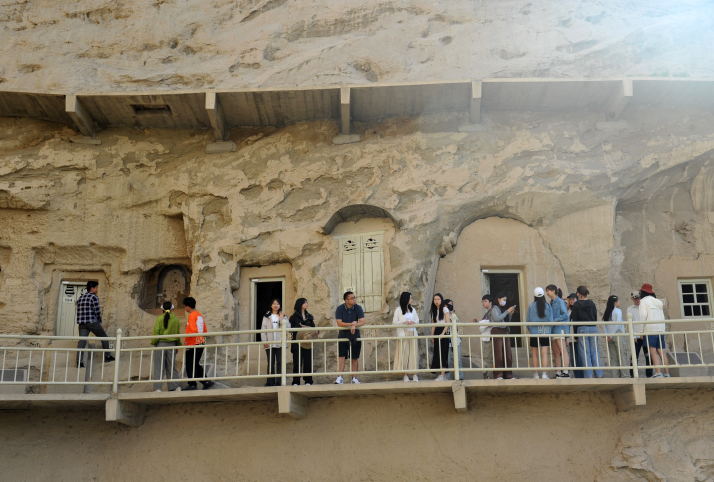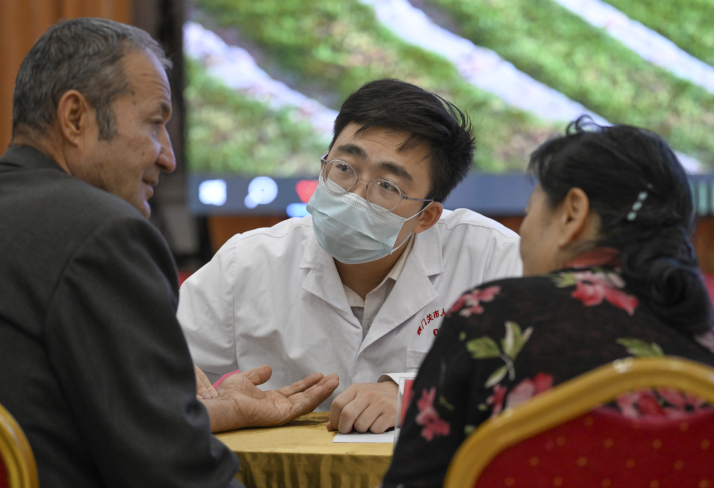| Xinjiang Today |
| Letting people see Xinjiang for themselves | |
|
|
 Peking University students visit the Kizil Grottoes in Aksu Prefecture on August 21, 2024. The grottoes are among the earliest Buddhist cave complexes in China, dating from around the year 300 to the eighth century (VCG)
On September 19, the State Council Information Office released a white paper, CPC Guidelines for Governing Xinjiang in the New Era: Practice and Achievements. Liang Yuchun, a professor at Xinjiang Normal University's College of Marxism and Dean of the university's Institute for Advanced Study of Ethnicity and Society, spoke to Xinjiang Today about the highlights of the document and the reasons for today's Xinjiang experiencing the best period of development in its history. Edited excerpts from the interview follow: Xinjiang Today: Given the concerns of some members of the international community, what key data and facts in the white paper demonstrate that the rights of all ethnic groups in Xinjiang have been comprehensively and fully safeguarded? Liang Yuchun: Due to a lack of understanding or being misled, some people in the international community have misunderstandings and misconceptions regarding Xinjiang's ethnic policies. The white paper demonstrates with detailed data and facts that the political, economic, social, cultural, environmental and other rights of all ethnic groups in Xinjiang have been fully safeguarded. From the perspective of political rights protection, Xinjiang has achieved remarkable results in advancing whole-process people's democracy, particularly consultative democracy. According to the white paper, as of 2024, 74,412 people were serving as deputies to people's congresses at all levels in Xinjiang. Of them, 78.69 percent were from the grassroots, and 69.21 percent from ethnic minority groups. In the same year, Xinjiang had 16,121 members serving on Chinese People's Political Consultative Conference committees at all levels, with 49.06 percent of non-CPC members and 46.13 percent of members from ethnic minority groups. The system of community-level self-governance has been established for all villages and communities across Xinjiang. Over 85 percent of the matters for decision-making at grassroots self-governance organizations come from public proposals. From the perspective of safeguarding economic rights, Xinjiang has maximized efforts to ensure voluntary employment and decent working conditions for people of all ethnic groups. The white paper states that employment rates are continuing to improve, with the region's employed population rising from 12.46 million in 2012 to 13.91 million in 2024, up 11.64 percent. People's income has increased. In 2024, the per-capita disposable income of urban and rural residents reached 42,820 yuan ($6,018) and 19,427 yuan ($2,730), an increase of 23,801 yuan ($3,345) and 12,551 yuan ($1,764), respectively, compared with 2012 figures. From the perspective of cultural rights protection, Xinjiang has vigorously promoted the prosperity and development of diverse ethnic cultures, creating a vibrant and mutually enriching cultural landscape. By 2024, Xinjiang had 9,545 verified and registered immovable cultural relics, among which six were world cultural heritage sites. The region also boasts three intangible cultural heritage items on the list of the UNESCO, and 141 items on the national representative list. All ethnic groups enjoy the rights to use and develop their own spoken and written languages, and to preserve and protect the fine traditional culture of their own groups. In terms of literary creations, the Tianshan Literature Award has been launched, and many Xinjiang-themed literary works have received nationwide acclaim. Public cultural services have been improved. By the end of 2024, Xinjiang had established 111 public libraries, 118 cultural centers, 1,126 cultural facilities in towns, townships and sub-districts, and 11,783 village cultural centers. From the perspective of social rights protection, Xinjiang has improved people's wellbeing, with remarkable achievements in poverty eradication. By the end of 2020, over 3.06 million of Xinjiang's impoverished rural population had emerged from poverty. The education sector has enjoyed all-round development. In 2024, the gross enrollment rate of preschool education, the completion rate of the nine-year compulsory education, and the gross enrollment rate of senior high schools were all above the national average. The structure of higher education has been optimized, while the scale of vocational education has been further expanded. The health service system has been improved and optimized. By 2024, Xinjiang had over 19,000 medical institutions of various types at all levels. The development of the health sector has helped improve people's health, with the average life expectancy in the region increasing from 30 years in 1949 to 77 years in 2024. The social safety net has been strengthened. By the end of 2024, the number of people under the basic old-age pension scheme and the basic medical insurance system stood at 16.91 million and 23.67 million respectively, each accounting for over 95 percent of Xinjiang's total population in their category. From the perspective of environmental rights, Xinjiang has advanced ecological progress with notable improvements in natural environmental conditions. The forest coverage rate increased from 4.24 percent in 2012 to 5.07 percent in 2024. Oasis area has expanded by 56.6 percent over the past three decades. The battle against desertification on the fringes of the Taklimakan Desert has been stepped up, with the desert now entirely encircled with a sand-blocking green belt stretching 3,046 km—the longest in the world.  A doctor from a major hospital provides free medical consultations to villagers in Yuli County, Bayingolin Mongolian Autonomous Prefecture, on September 19 as part of the hospital's efforts to improve access to healthcare (XINHUA)
As a core area of the Silk Road Economic Belt, what are Xinjiang's achievements in the implementation of the Belt and Road Initiative? What are the new plans for enhancing connectivity with Central Asia, Europe and other regions in the future? Xinjiang aims to build a golden channel across the Eurasian continent and a gateway for opening up to the west. It has achieved remarkable outcomes in advancing the Belt and Road Initiative. It has established 19 ports. A total of 16,400 freight trains traveled through Xinjiang on the China-Europe Railway Express in 2024. The number of Xinjiang's economic and trade partners also increased to 211 in 2024. Trade volume has expanded, with the total import and export value surging from 158.96 billion yuan ($22.34 billion) in 2012 to 434.16 billion yuan ($61.02 billion) in 2024. The China (Xinjiang) Pilot Free Trade Zone was approved and set up in October 2023. Over the following year, more than 9,000 enterprises moved into the zone. In the future, Xinjiang will accelerate high-level opening up by deepening connectivity with Central Asia, Europe and other regions. Efforts will focus on building Urumqi into a regional international commercial and logistics hub, an international inbound goods distribution center and a comprehensive international aviation hub serving Central and West Asia. More China-Europe (Central Asia) railway services and flight routes will be launched.  A volunteer helps primary school students with their homework at a summer vacation daycare center in Awati (Awat) County, Asku Prefecture, on July 5, 2024 (VCG) In 2024, over 500 foreign delegations visited Xinjiang. What role has this "seeing is believing" approach played in changing external perceptions of Xinjiang? How can we further encourage such exchanges? International coverage of Xinjiang has been a mixed bag. Some reports stick to the facts, capturing the region's genuine progress—social harmony, a growing economy and the improving lives of its residents. Too often, however, the narrative is clouded by ideological bias, presenting a distorted picture that misleads global audiences. To set the record straight, Xinjiang has been opening its doors. Foreign visitors—from diplomats and journalists to academics—are seeing the region for themselves. They encounter a modern, developing and peaceful place, a reality that directly challenges the grim portrayals in some media. These first-hand experiences are crucial for breaking down the "information bubble" and allowing a more complete story to emerge. We're seeing more balanced international reporting on Xinjiang, and its reputation as a compelling destination is growing. Looking ahead, the path is clear: Welcome more people. Boosting tourism through international marketing and more direct flights would bring in more visitors. Furthermore, expanding international student enrollment at local universities and hosting more major international sports events would provide more outsiders with a direct, unfiltered experience of the region. The most powerful rebuttal to misinformation is simply letting people see Xinjiang for themselves. When they do, the vision of a beautiful Xinjiang will stand on its own. Comments to luyan@cicgamericas.com |
|
||||||||||||||||||||||||||||
|